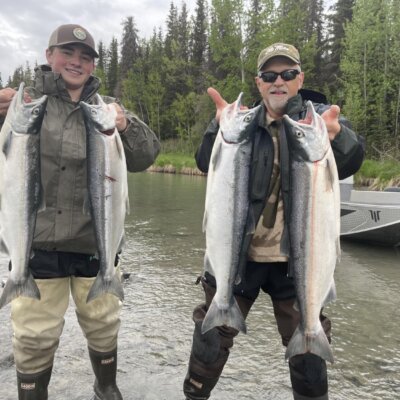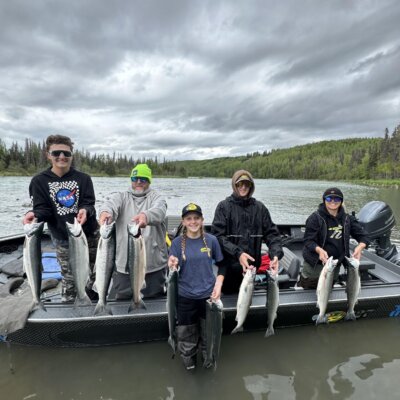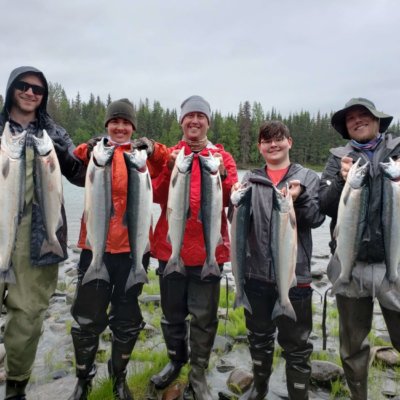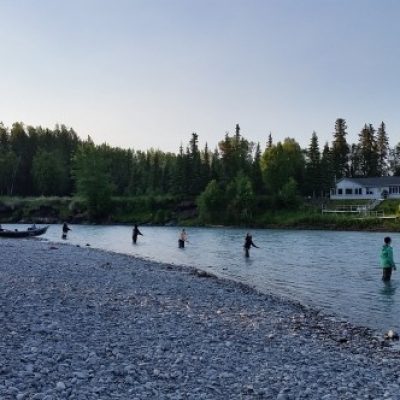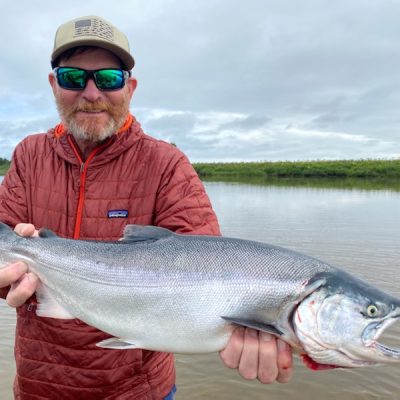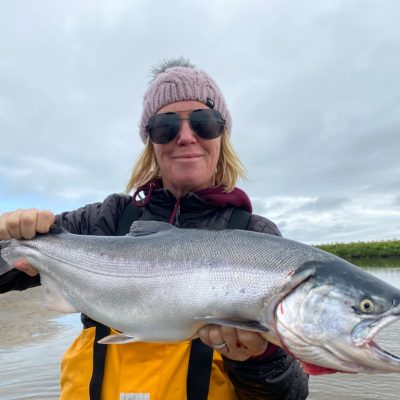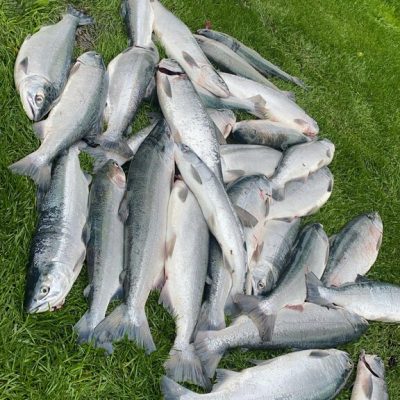
14 Jan How to Catch Sockeye Salmon on the Kenai River
Kenai Sockeye Salmon Fishing Guides

Fishing for Kenai Sockeye is not rocket science but it can be somewhat intimidating for those new to the fishery as the technique and gear is a lot different than what most people would expect. Run timing, where to fish and understanding the specific technique required are all contributing factors toward be successful at catching sockeye salmon. Hiring a guide will help tremendously with reducing the learning curve and a good guide will not only make sure you go home with a limit but also with the knowledge to master the technique. Our guides are patient and will work with you one on one to make sure you depart the river with not only a big bag of fileted fish but also with the satisfaction of knowing you mastered the technique. Call us today for the best available sockeye salmon dates or click the link below to make a reservation:
Click Here to make a Sockeye Salmon Reservation!
Kenai River Sockeye: Are they shy?
Sockeye or Red salmon, Oncorhynchus nerka. Often called the “shy” salmon, the sockeye is perhaps the most mysterious of the five pacific salmon. Typically present in astronomical numbers, they can transform even the smallest creek into a churning highway of back-to-back fish. Highly coveted for their very rich meat, the red salmon has long been Alaska’s most valuable commercial target, netting the industry several hundred million dollars annually from Kenai River sockeye salmon fishing alone. In recent years they have also generated a huge Sportfishing reputation as more anglers have finally figured out how to catch sockeye salmon. Learn more about this Alaska Fishing staple.
The sockeye’s reluctance to take a lure has caused more than one visiting angler to scratch their head. The guy next to you hooking one on every cast can further acerbate the frustration. Everyone new to the sport of red fishing has been there. Until you master the proper technique demonstrated by sockeye salmon fishing guides and understand some fundamental premises about how to catch sockeye salmon in Kenai River, you too will scratch your head. Let’s clear the water.
Since sockeye are the one salmon species that feed almost exclusively on blooms of plankton, their level of aggression is far lower than their meat-eating cousins. They take on a passive, solemn appearance as they plod their methodical, almost generic journey upriver to spawn. Don’t be fooled. Beneath that seemingly simplistic exterior lies a very complex wild creature with an endless supply of energy and strength. Sockeye are amazingly uniform in appearance with most weighing between six and ten pounds. The state record was taken on the Kenai in 1974 and weighed 16lbs.
Possessed with an unstoppable will to reach their spawning grounds, sockeye move upriver at remarkable speeds after leaving the sea. On the Kenai, it is not at all uncommon to have sea-lice fish (a parasite that drops off after 24 hrs. in fresh water) 50 miles upriver. With their unmatched stamina, these silver torpedoes provide the wildest fight of all Alaska’s salmon. That is, if you know how to catch sockeye salmon. And that is where our sockeye salmon fishing guides come in.
1. Your Presentation
Understanding the reasoning behind the sockeye’s reluctance to strike will help tremendously when attempting to put one on the hook (and into the freezer). You won’t need the fist sized bait of eggs and a spin ‘n glow that is so deadly with the kings. Nor will you want the chrome bladed spinner that most consistently entices the silvers. For the sockeye, you want a very simple and small presentation and believe it or not, a bare hook is very effective. That’s right, a bare hook. Some will add a small piece of colored yarn or tiny float but the key seems to lie in the presentation rather than what you are presenting.
2. Where To Cast
Perhaps the most important of all the critical factors for how to catch sockeye salmon is sheer concentration of fish, as our sockeye salmon fishing guides will tell you. Since your offering passes the mouths of far more fish when many are present, your chances of one ending up with your hook are greatly increased. Makes sense, right? Sockeye notoriously travel within 2-5 feet of the shoreline, so you’ll need to be standing on the bank rather than in a boat. Sometimes the best way to learn a new fishing technique is to first watch an experienced angler in motion. The well-weathered red angler will stand out like a sore thumb with the repetitious, almost robot like flips upriver. Short methodical swings with the rod are the foundation for how to catch sockeye salmon. You “plop” your hook upriver enough to get your weight to the bottom and draw it as straight as possible across the current and through the passing fish. The amount of lead to use is critical and always different depending on the strength of the current.
3. Weight Of Your Line
Usually, a swift current and water between 2-5 feet deep is ideal. With too much weight your lure will be constantly stuck in the rocks and this makes for a poor drift. Our sockeye salmon fishing guides teach that you want your weight to simply tick the bottom, not grab it. Once you have mastered how to catch sockeye salmon with the art of flipping your line upriver and swinging it across the water with your lead consistently ticking the bottom, you are well on your way. With your fly trailing your weight by 3-5 feet, it will regularly pass through the bulk of the fish which are within a foot of the bottom, and constantly opening and closing their mouths to aerate their gills. Herein lies the controversy of these fabled salmon, as many believe the inevitable hook-up that results is simply your line finding one of many opening and closing mouths. As you pull back to make yet another short swing, your hook meets jaw and a top water explosion immediately ensues.
Did the salmon suddenly strike the passing hook or did your repetitive technique combined with thousands of passing salmon, make the hook up a mathematical certainty? Since many times your hook finds the fish’s tail or dorsal fin, it seems the latter may be more plausible. Nevertheless, this technique for how to catch sockeye salmon, when mastered, will consistently hook sockeye right in the corner of the mouth. The battle is unmatched. Even the most religious light-line purists and sockeye salmon fishing guides will spool up 20-30lb. test (at least) to ensure half their hook ups will result in bringing the fish to hand. Due to their relative abundance, the limits for sockeye are liberal and this means you can accumulate an entire winter’s worth of vacuum-packed filets in one or two outings. It’s not tough to figure out why so many Alaskans make Kenai River sockeye salmon fishing an important part of their summer.
Sockeye Salmon Runs
The Kenai receives two separate runs of sockeye salmon, one in mid-June and the other in late July. The June run is headed almost exclusively for the Russian River, a clear water, mountain tributary that dumps into the upper Kenai just below Cooper Landing. This is a very strong run in which thousands of fish stack up at the confluence where the Russian meets the Kenai. Guess what, so do the crowds, and it is here that the term “combat fishing” was born. Hiking up into the Russian itself will separate you from the crowds, but despite the wilderness surroundings, lots of people and the Russian River go hand in hand. Especially when the red run is at its peak. Don’t despair there’s plenty of free entertainment and fish, so get right into the middle of it. You’ll definitely need hip waders, lots of gear, and eye protection. The Russian River run typically sees over 30,000 fish but it’s the main Kenai that really produces the numbers.
Peaking in late July, this enormous push of red salmon will usually reach one million strong once the entire run has entered the river. This mob of reds will spread itself out from early July to mid-August. When the run is at its peak we will see 50,000 fish days and as you can imagine, the fishing is quite good.
So as you’re planning the day to day fishing schedule for your next venture to Alaska, be sure to build in a few days of red fishing. Remember to be patient, and forget any previous fishing experience you may have. This is a one of a kind technique for a one-of-a-kind fish. Once you’ve had one of these silver torpedoes nearly pull you into the river, you too will be hooked.
Are you looking for a sockeye salmon fishing guide to show you how to catch sockeye salmon and ensure that your Kenai River fishing trip is a success? Book an Alaska Kenai River fishing trip today!
